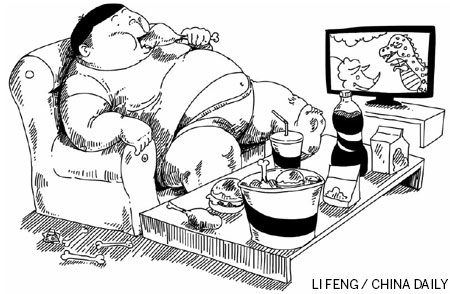Child's obesity is outpacing growth12
Updated: 2013-05-30 08:08
By Cesar Chelala (China Daily)
|
||||||||

Obesity in China, particularly among children, has become a growing health concern that will not only seriously affect the health of future generations but also place a heavy economic burden on the country. In 1982, only 7 percent of the population was obese, now, according to the World Health Organization, more than 38 percent of Chinese above the age of 15 are overweight.
To make the situation even more serious, China - as well as Vietnam, India, and many other developing countries - has to shoulder a "double burden": the persistence of undernutrition, particularly among children in rural areas, and a rapid rise in obesity and overweight-related diseases such as cardiovascular disease, hypertension and strokes, type II diabetes and certain forms of cancer.
Although the terms obese and overweight are sometimes used interchangeably, they have different meanings. The body mass index is used to determine body fat based on a person's weight and height. A healthy BMI is considered to be between 18.5 to 25. A person with a BMI between 25 and 30 is considered overweight, while a person whose BMI is more than 30 is considered obese. Morbid obesity refers to someone with a BMI of 40 or more.
Overweight is not only a problem in developing countries alone; it is a problem worldwide. In the United States, the number of overweight children has doubled and the number of overweight adolescents tripled since 1980, according to the US Surgeon General.
In Chinese cities, according to official statistics, 15 percent of children aged 10 to 12 are considered overweight and an additional 8 percent are obese. A University of Southern California study carried out in 2006 found that the average body fat of Hong Kong children was 21 percent, which is extremely high.
The basic cause of obesity among children and adolescents is the energy imbalance between the calories they consume and the calories they expend through activity. But the causes of the increase in the number of overweight and obese children and adolescents are different.
There are several reasons to explain the increase in obesity in China. Traditionally, the Chinese diet consisted mainly of cereals and vegetables, with a little meat. As a result, the fat and sugar intake of the Chinese people remained low for a long time. However, as the country experienced an explosive economic development, fatty and sugary foods became much more widely available.
Due to the general population's ignorance of what constitutes proper nutrition, their consumption of fatty and sugary foods has increased significantly in the last decades, and so have the problems associated with it. Because of past famines in the country, different types of food, particularly high-fat food, are now very attractive, while the consumption of cereals, fruits and vegetables has decreased.
Eating in fast food places, particularly franchises of US fast food chains such as McDonald's, Pizza Hut or Starbucks, where the food is particularly high in fats and sugar, has become very popular. Although food in these places is expensive by Chinese standards, they offer an atmosphere that many Chinese find attractive, particularly young business people.
The attraction of fast food is not going to disappear. Instead, a new trend is developing. It started in Hong Kong, where McDonald's restaurants offer what has been called "McWeddings" where they provide wedding receptions for young couples. McDonald's will open a total of 250 new restaurants this year and expects to have 2,000 restaurants across China by the end of 2013. China's fast-food industry is now the fifth-largest in the world.
Another important factor for the increase in obesity levels in the general population is inadequate physical activity as a result of the increased use of television, computers and other passive leisure activities. The lack of safe and adequate spaces for physical exercise, and increased car ownership have also led to drastically lower levels of physical activity.
To confront the problem, it is necessary to cultivate healthy eating practices and healthy lifestyles for children. It is also important to increase the public's understanding of good nutrition through the mass media and the creation of community-based education programs.
Several countries have been experimenting with the use of fiscal measures to limit the consumption of foods high in fat, sugar and salt. Higher taxes on unhealthy foods can help improve health by changing eating habits, while at the same time generating important revenues that can be used for prevention efforts. The challenge for policymakers is how to develop effective programs and policies aimed at preventing and controlling what is fast becoming a serious public health problem, while at the same time allowing the people to enjoy the benefits of the country's remarkable economic growth.
The author is a public health consultant for several UN agencies and international organizations.
(China Daily USA 05/30/2013 page12)

 Michelle lays roses at site along Berlin Wall
Michelle lays roses at site along Berlin Wall
 Historic space lecture in Tiangong-1 commences
Historic space lecture in Tiangong-1 commences
 'Sopranos' Star James Gandolfini dead at 51
'Sopranos' Star James Gandolfini dead at 51
 UN: Number of refugees hits 18-year high
UN: Number of refugees hits 18-year high
 Slide: Jet exercises from aircraft carrier
Slide: Jet exercises from aircraft carrier
 Talks establish fishery hotline
Talks establish fishery hotline
 Foreign buyers eye Chinese drones
Foreign buyers eye Chinese drones
 UN chief hails China's peacekeepers
UN chief hails China's peacekeepers
Most Viewed
Editor's Picks

|

|

|

|

|

|
Today's Top News
Shenzhou X astronaut gives lecture today
US told to reassess duties on Chinese paper
Chinese seek greater share of satellite market
Russia rejects Obama's nuke cut proposal
US immigration bill sees Senate breakthrough
Brazilian cities revoke fare hikes
Moody's warns on China's local govt debt
Air quality in major cities drops in May
US Weekly

|

|







